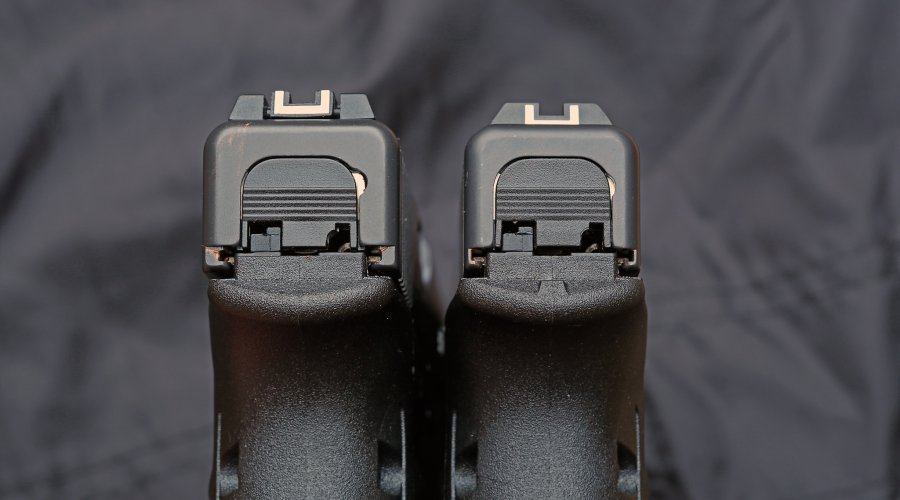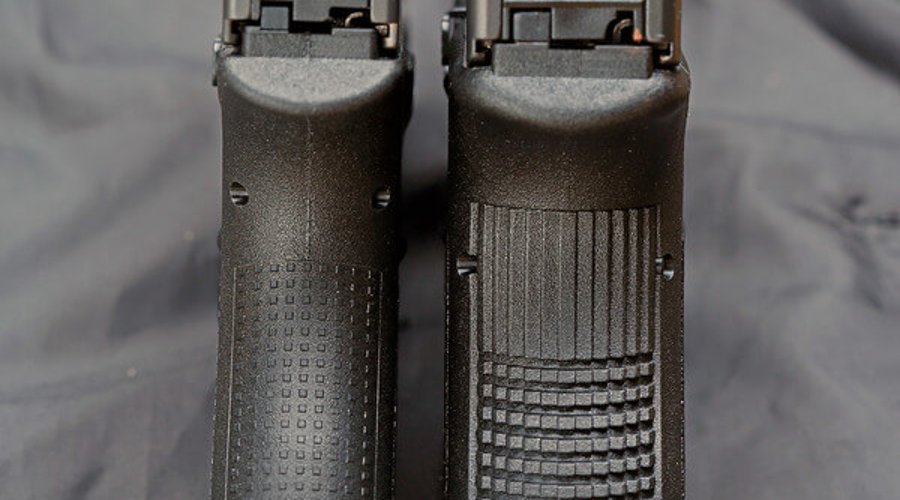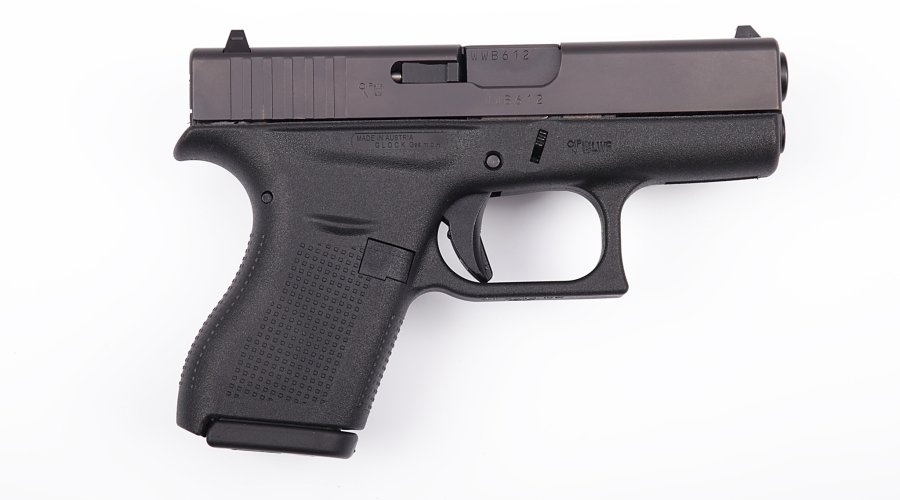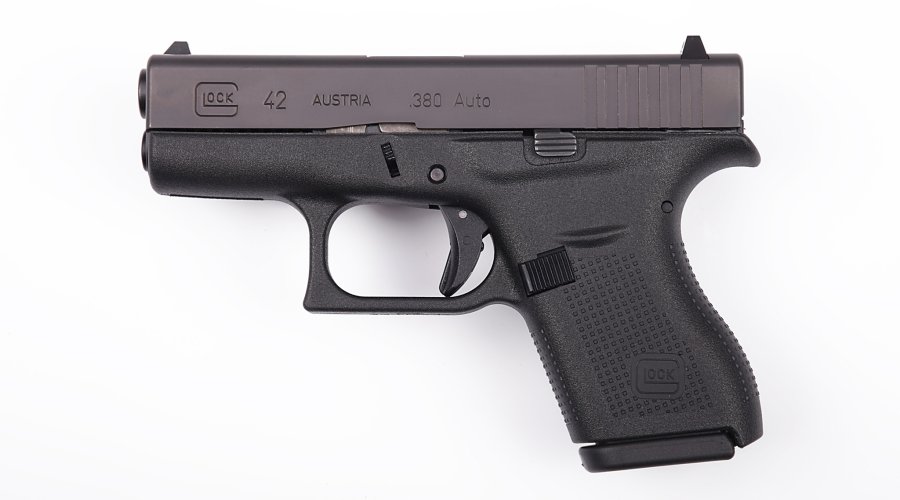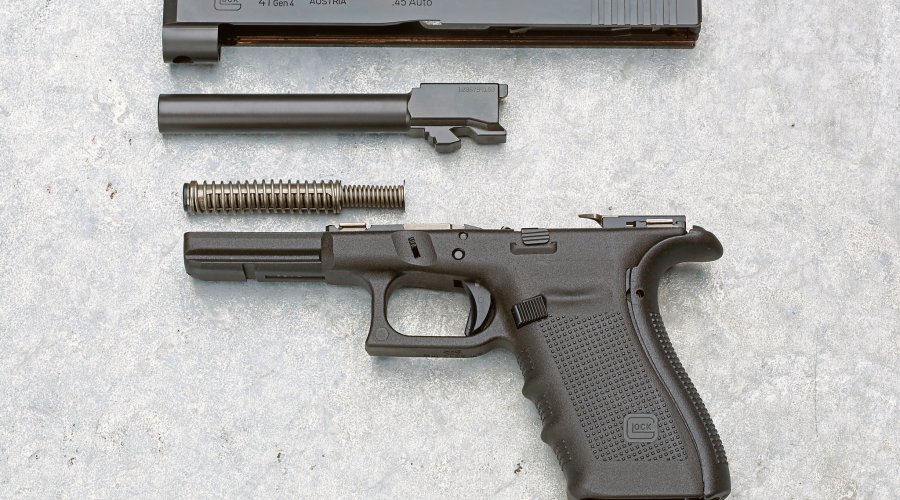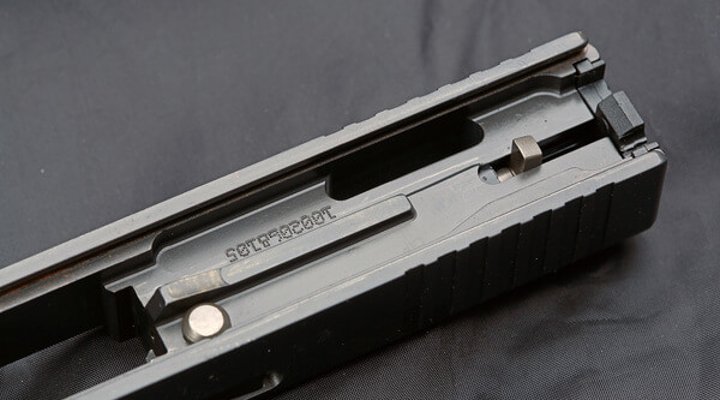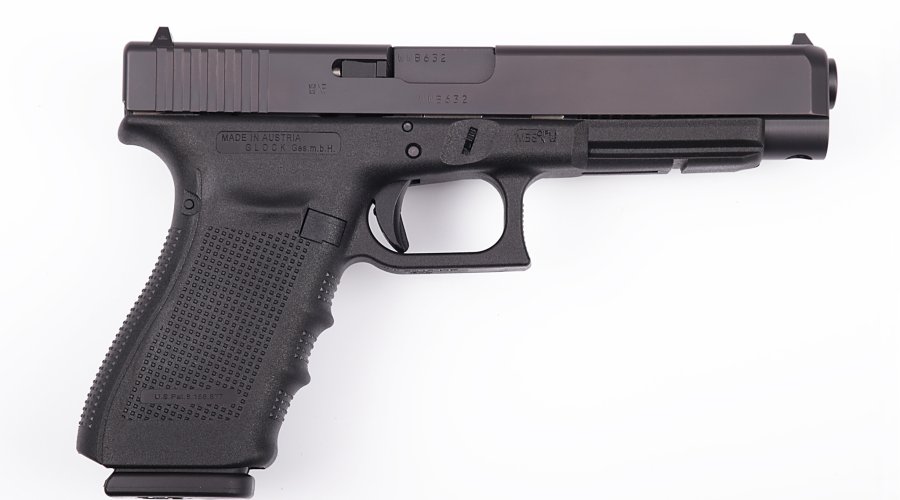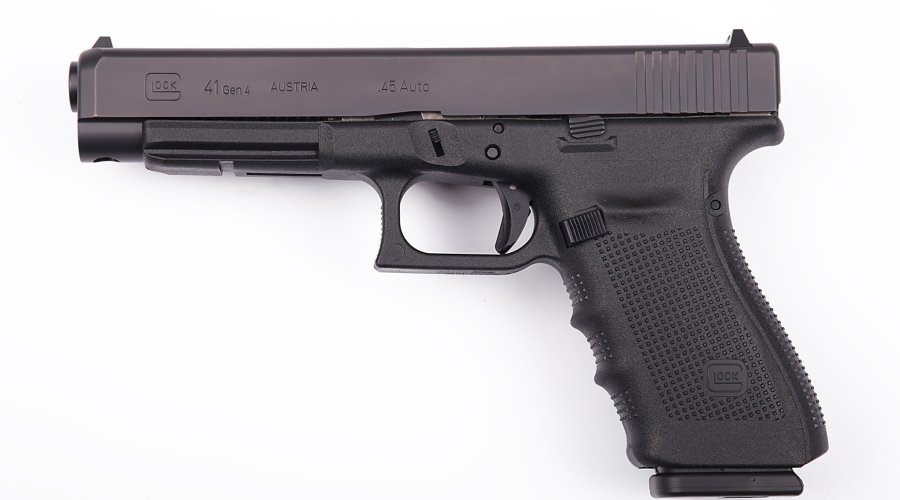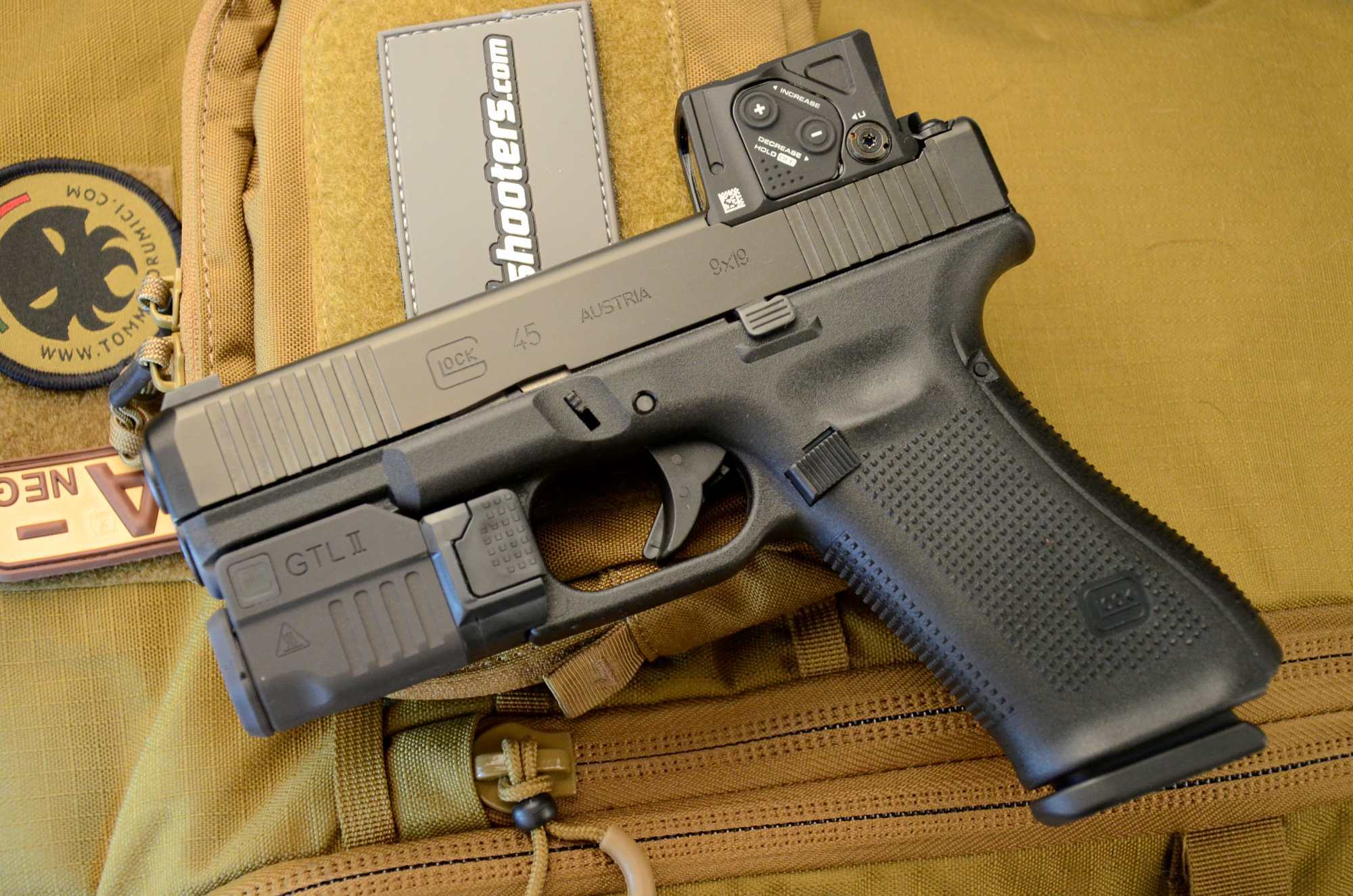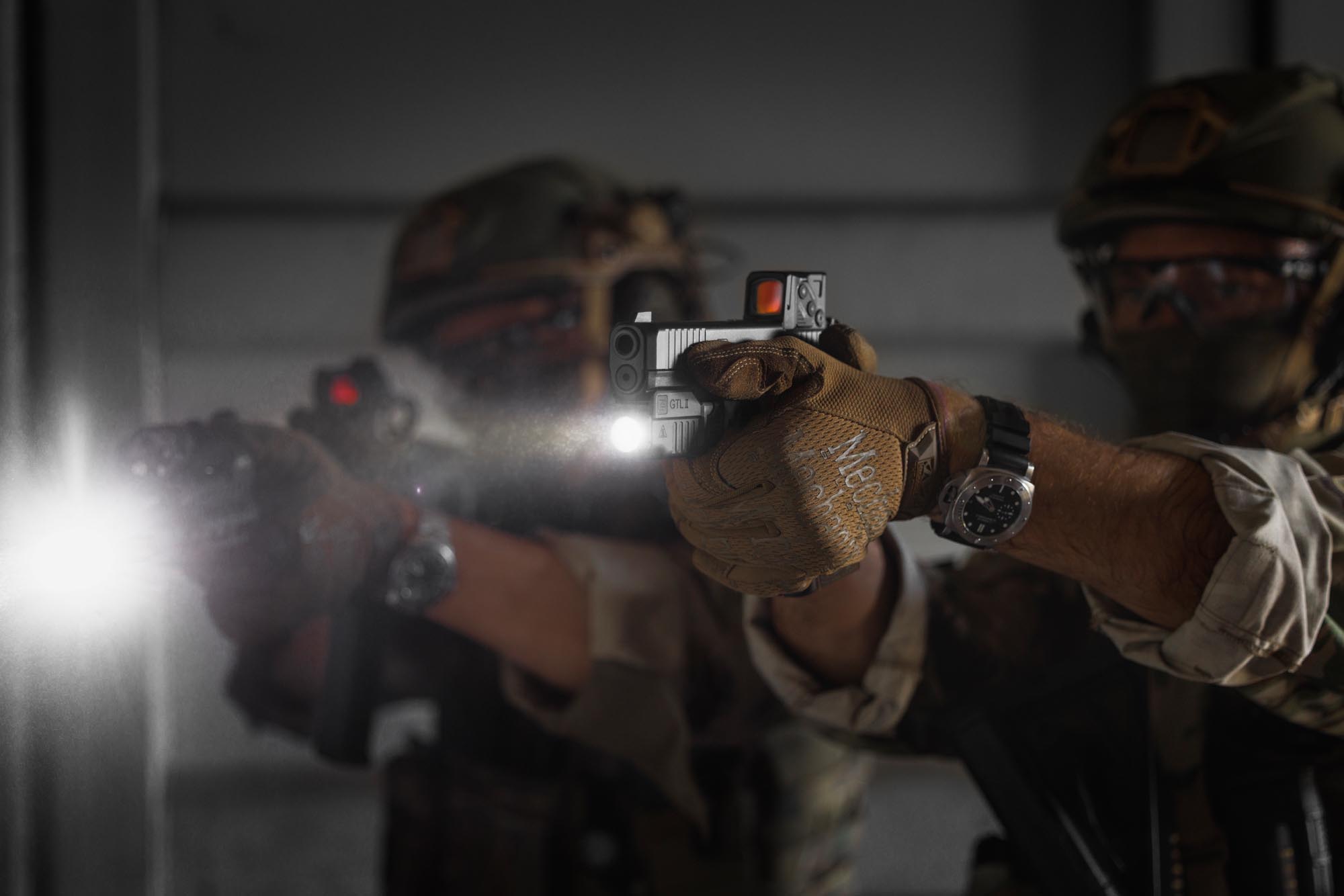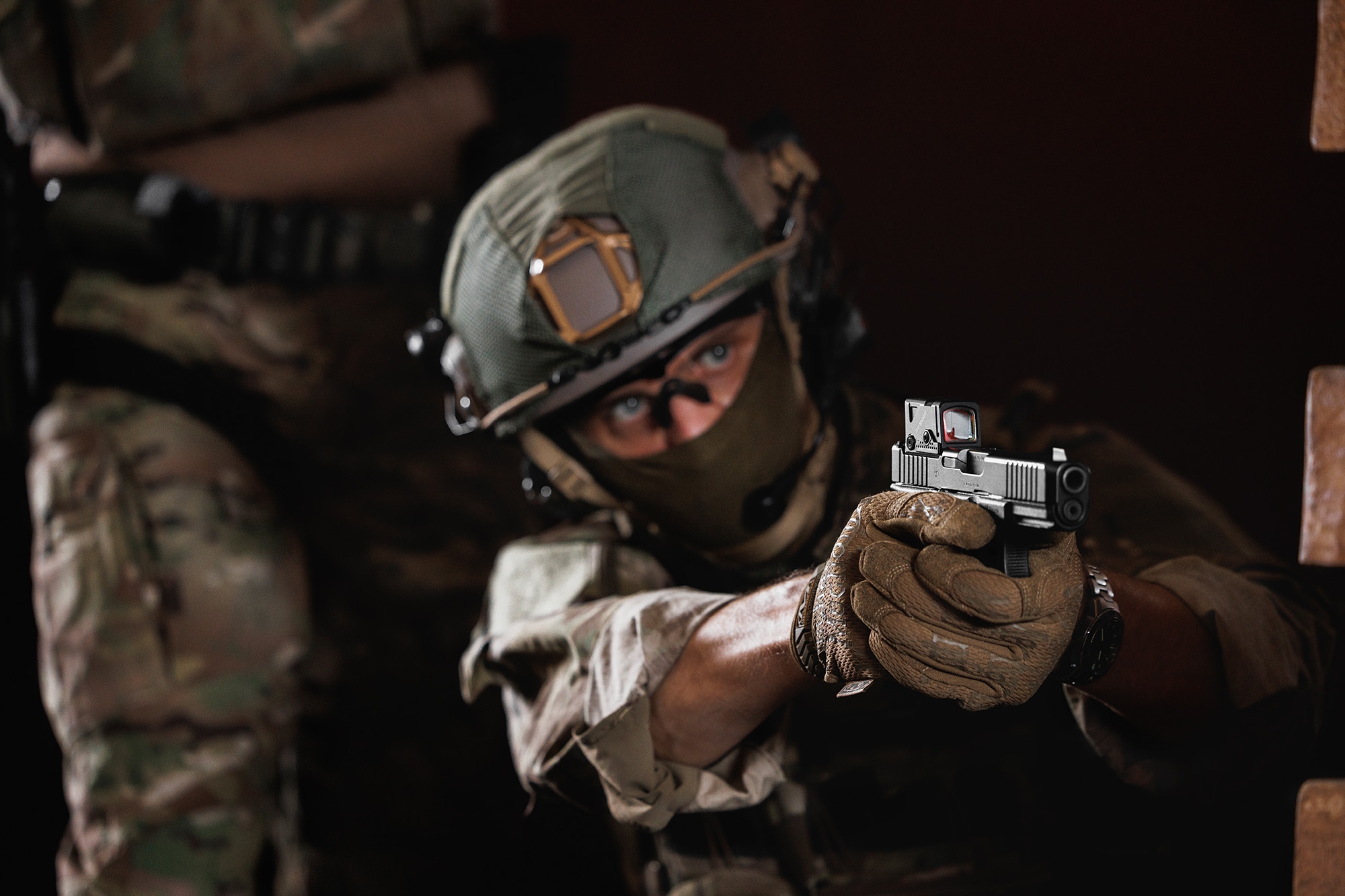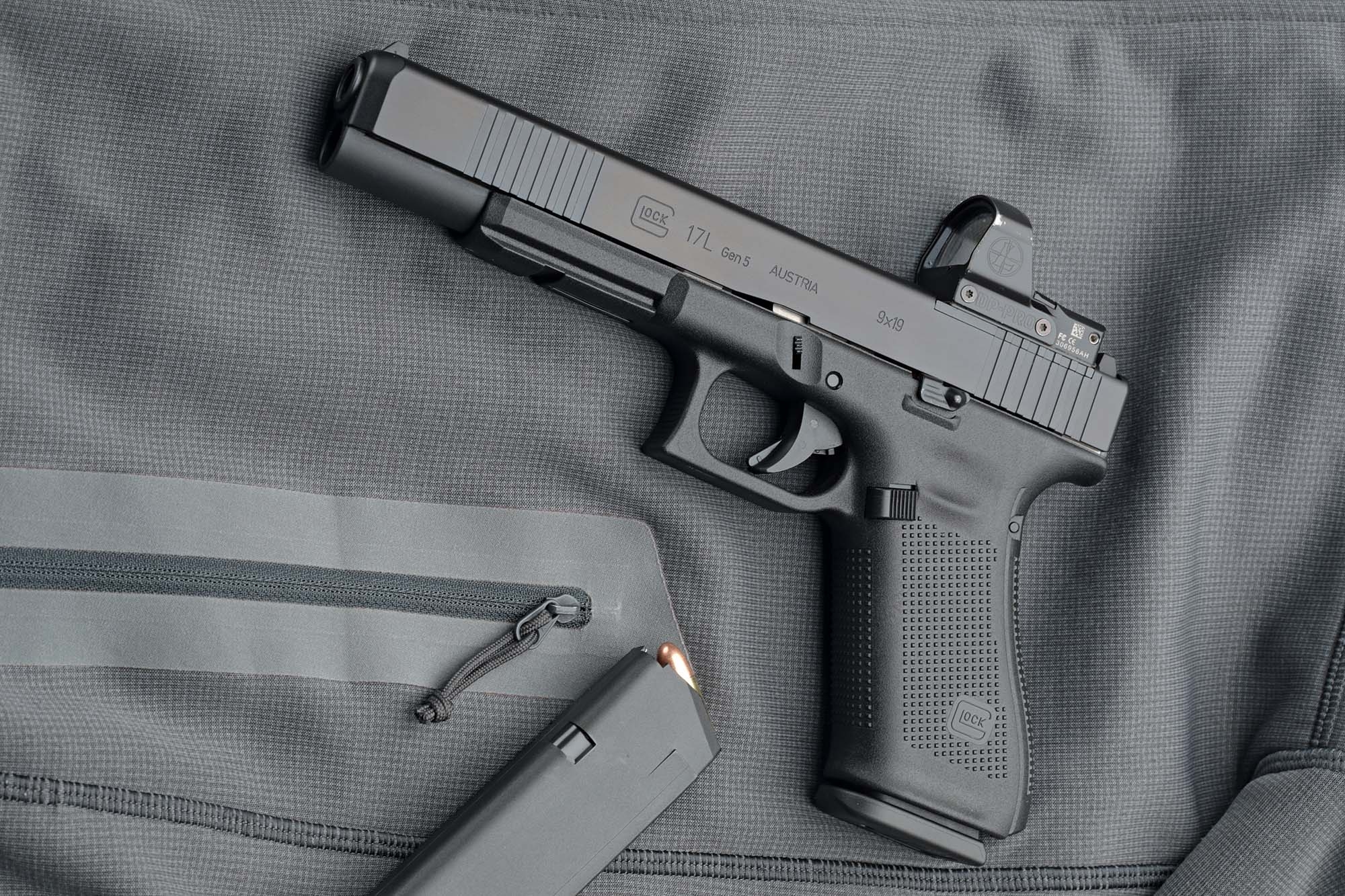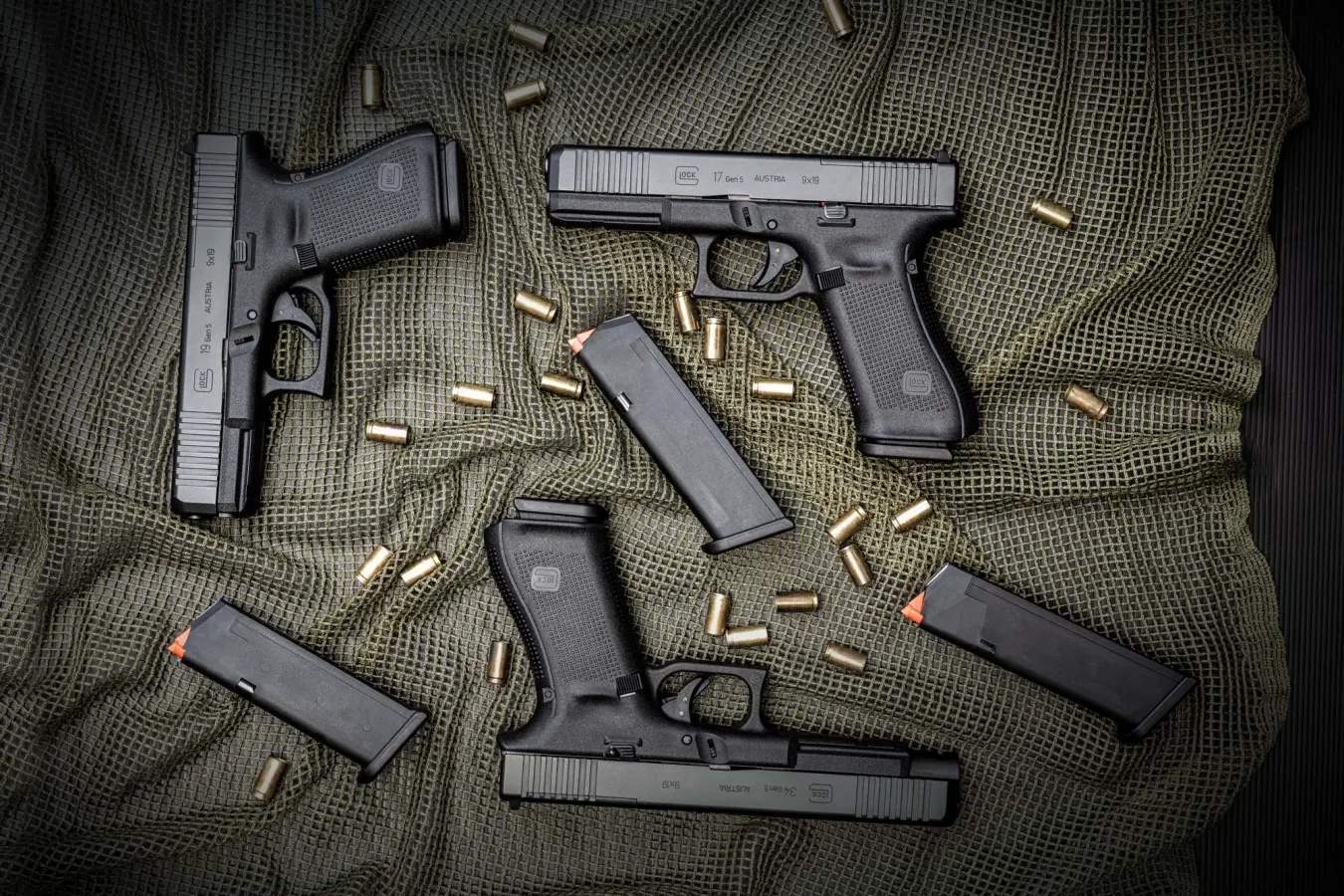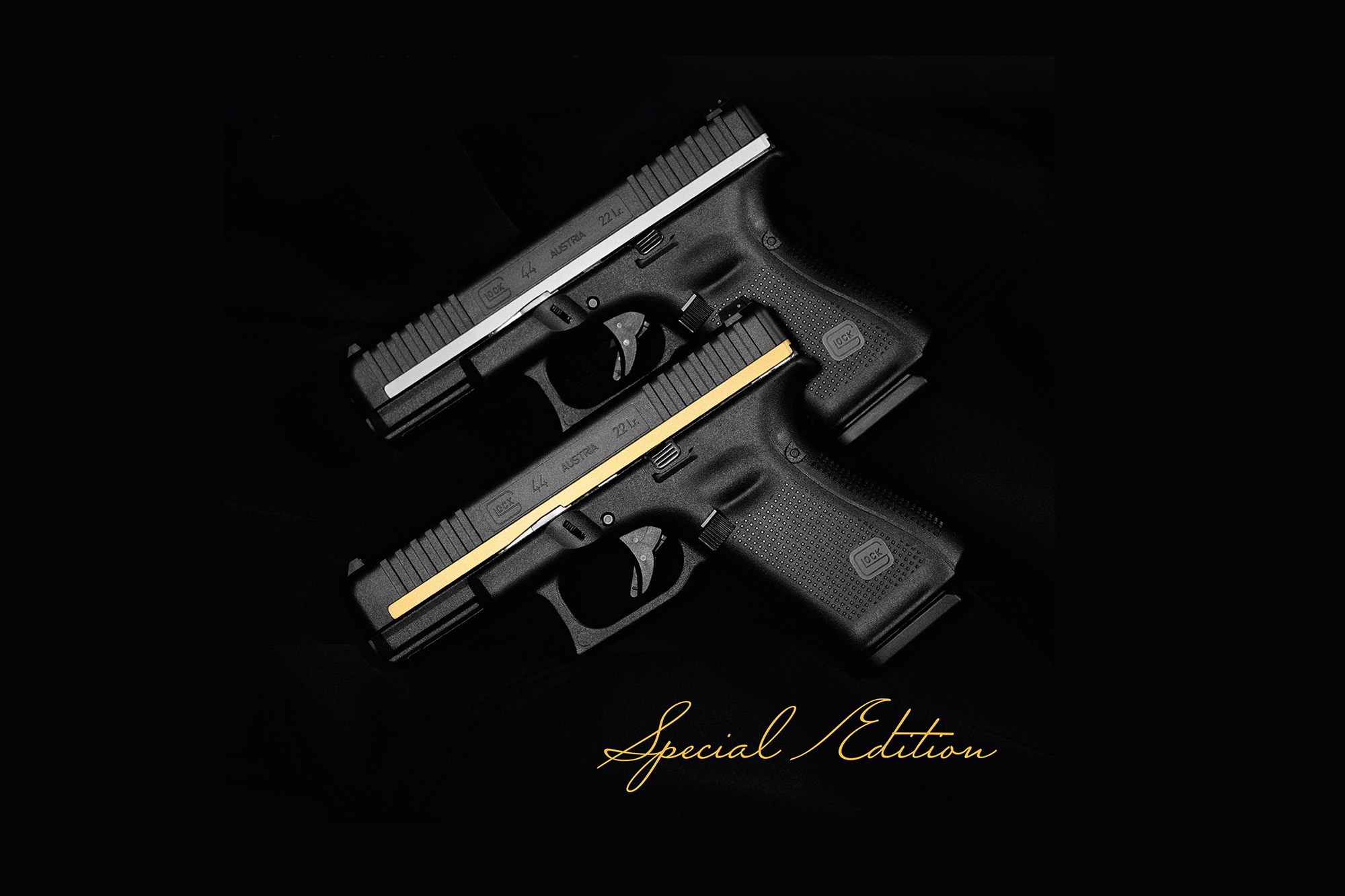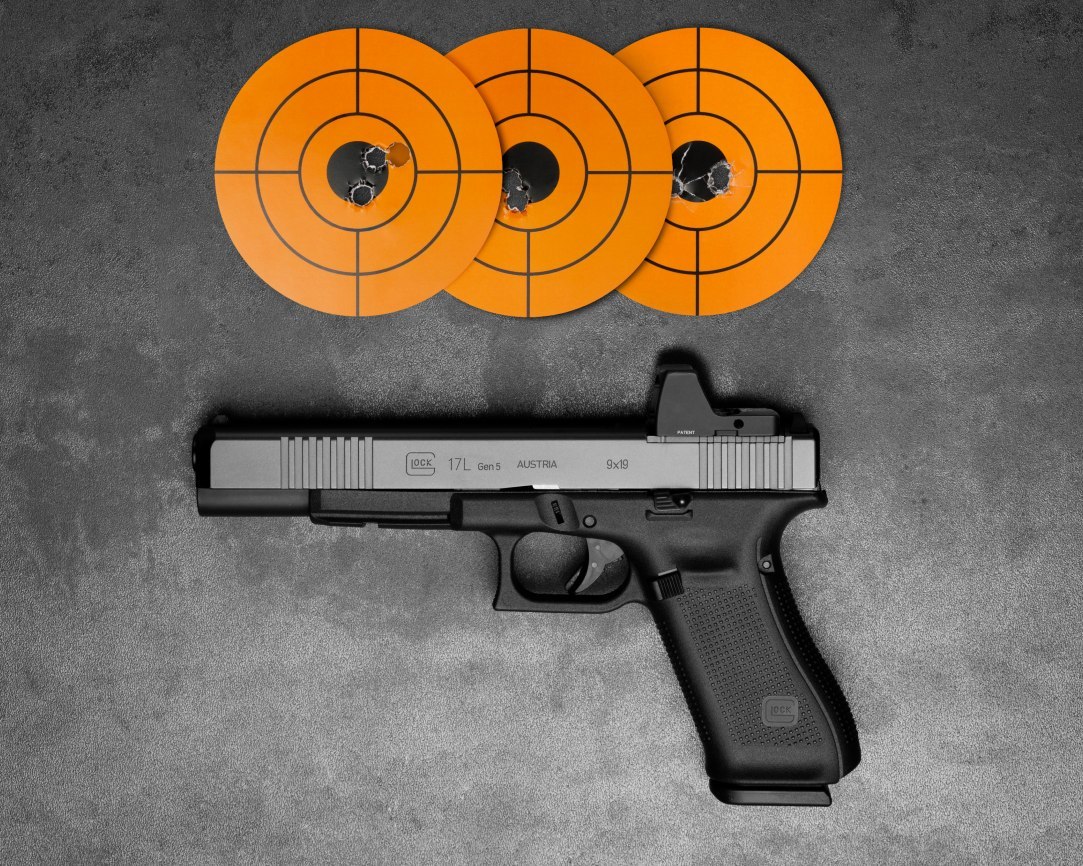Article also available in other languages


The whole world, the United States in particular, sits up and takes notice when GLOCK, the prolific manufacturer based in Deutsch-Wagram near Vienna in Austria, launches a new pistol model. This is due in no small part to the widespread and immense popularity and circulation of the classic polymer pistols whose production figures recently broke through the magic 10-million threshold and therefore can quite rightly assert a position as all-time favorites. Expecting substantial sales of the pocket-sized pistol, a large American ammunitions manufacturer has even taken steps to expand its .380 Auto caliber with dedicated loads for the Glock G42. Now that is a hefty sign of respect!
GLOCK G41 in .45 Auto
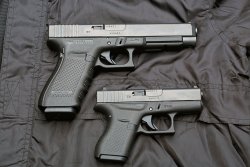
The longer slide, housing the 135mm, polygonal profile barrel and a rifling twist length of 400mm, is the most eye-catching feature of the GLOCK G41. So the recent addition from Deutsch-Wagram is a magnificent complement to the GLOCK G34 in 9mm Luger and the Glock G35 in .40 Smith & Wesson, released as far back as 1998 and tailored precisely to match the rules issued by the American IPSC association USPSA (United States Practical Shooting Association). The extended sight radius and improved weight distribution are intended to appeal to customers who like things that bit more sporting and dynamic. Production of the GLOCK G17 L in 9 mm Luger and GLOCK G24 in .40 S&W, models with 6"/152mm barrel length, stopped some years ago. In the G41 model, GLOCK trusts in a narrower, far more appealing slide that premiered back with the G30 S in .45 ACP. The 28.5mm width (the GLOCK models G21/G30) is cut to 25.5mm (the new GLOCK models G30 S/G41) and not only improves the look, but also reduces the moving mass on shot discharge, hence improving its shooting behavior.
A glance at the scales speaks a clear and unequivocal truth. The slide weight of the long G41 is 398g, while a normal G 21 slide comes in at 472g. This 72g weight reduction is certain to boost functional reliability when using soft target loads. The 195mm sight length means the new .45 delivers an added 18mm compared with the full-size models G21/SF/Gen4.
Our test weapon was still fitted with a fixed rear sight. But there have been whispers that it is soon to be replaced with GLOCK's own familiar, adjustable sight. The GLOCK Safe Action trigger is fairly typical and hence somewhat lacking in the sporting touch; our test weapons required 3200g to reach discharge. Anyone keen on a lower trigger weight will have to look for dedicated tuning components and specialized gunsmiths. But thankfully there are plenty of them around. It is important to mention, however, that slashing the trigger weight while using ammo with hard primers can quickly prompt misfiring.
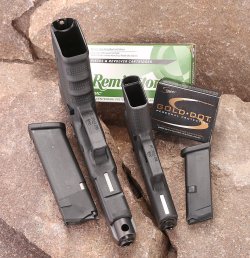
The polymer frame is a tried and tested Gen4 SF (small frame) design, whose circumference is slightly narrower than the former G21 grip stocks used in earlier generations. Among the features included we find replacement back straps for both weapons (MBS; modular back straps), now equipped with an extended beavertail, to enable three different distances to the trigger and to provide greater accommodation of individual needs.

Nevertheless, the roughly 32 mm broad grip stock is more suited to medium-sized and larger hands. Any fans of the single-stage GLOCK triggers may find the GLOCK 41 an interesting asset among polymer pistols in the .45 Auto caliber with its pronounced mushrooming. Its deployment in a dynamic range, such as the JPSC standard class, would also be possible. But this would be better suited to the GLOCK 35 in .40 S&W due to the greater magazine capacity of 15 rounds. The G41 comes with a similar price to the GLOCK 34 and 35, retailing at €841.
GLOCK G42 in .380 Auto
The market for small and easily concealable weapons is booming in USA, as almost all states presently allow law-abiding citizens to carry weapons, subject to more or less stringent regulations. When Sturm, Ruger & Co presented its Ruger LCP (Lightweight Compact Pistol) in .380 Auto at the SHOT Show 2008, the entire production was sold out for two years in advance in no time at all.
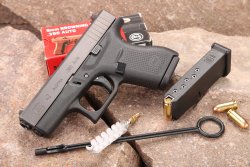
So it's barely surprising that other weapon manufacturers such as GLOCK are keen to sink their teeth into a fat slice of the 'concealed carry' market. We are more familiar with .380 Auto caliber under the 9mm short name, although the CIP (Commission Internationale Permanente pour l’Epreuve des Armes à Feu Portatiles) officially carries it as 9mm Browning-Court. And in addition to the aforementioned equivalent terms, there is a whole series of synonyms used for this cartridge, which has been around since 1912. John Moses Browning's redux design is found behind such titles as 9mm Browning short, 9mm pist. cartridge 400 (h), 9mm M.34 , .380 C.A.P.H., DWM 540, 380 Auto Webley, .38 Colt Auto Hammerless, .380 (9mm) Auto, besides the designation .380 ACP frequently found on ammunition boxes. It is the commonest commercial cartridge alongside the 9mm Makarov used in the Eastern hemisphere, designed for small pistols with simple blowback system.
The .380 caliber – GLOCK revisiting familiar terrain
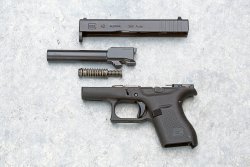
It's nothing new for the Austrian manufacturer to produce a pistol in .380 caliber; after all, GLOCK launched the G25 model whose exterior dimensions are best compared with a GLOCK 19, back in 1995. The company was mainly targeting sales in countries in which owning weapons in military and police calibers is forbidden, as remains the case in individual countries of Central and South America. The G28, a subcompact version in .380 Auto, followed in 1996. It also came with just one grip stock for a double-row magazine; but it's shorter length accommodated only 10 rounds instead of 15. Interestingly, both of these models are only sold to law enforcement in the United States.
By contrast, the new G 42 is also available to american civilians, and your average central European has trouble understanding the almost rapturous delight with which the GLOCK fan community received this announcement.
The advance order numbers passed on to us are so impressive they almost seem incredible for the smallest pistol in the GLOCK program. With an unloaded weight just south of 394g and the diminutive dimensions of 152mm length by 106mm height and 23mm width, the GLOCK G42 is a real 'pocket-sized champion' that immediately proves appealing. Its engineering is based on the predecessors GLOCK G25/G28, a simple, high-duty blowback locking mechanism and a single-stack magazine to accommodate a mere six rounds in 9mm short. But anyone packing the dwarf loaded with 6+1 cartridges in 'appendix carry', a particularly popular method in the United States, for example, still has two rounds of additional firepower compared to someone wearing a typical snub-nosed revolver before we even get onto the lower weight, the narrower design and the carrying comfort these factors deliver.
The surface finishing on the grip panels and the convertible magazine release are entirely reminiscent of the fourth-generation models, even if the smallest GLOCK does without an exchangeable back strap. The inner workings are home to the typical, two-part telescope recoil spring, like in all subcompact models by the Austrian manufacturer. The relatively high 3885g trigger weight may be due to it being the first series, although the G42 is factory fitted with a 2.5 kg deflector.
Shooting range report with the new GLOCK 41 and 42:
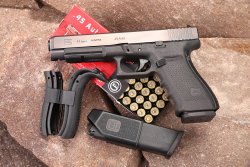
Given that the GLOCK G41 has a 'longslide' design, just like the G34/G35, intended for sporting use, we conducted this precision test over a 25 m distance using a sandbag rest. A total of six loads were used, four factory and two hand loads, with a bullet weight range between 85 and 230 grains. The good news first: neither of the weapons malfunctioned during any of the roughly 300 shots fired. It wasn't exactly easy to control precision with the circa 3200 g trigger weight, to put it mildly.
The standard replacement of the rear sight with a 3.5mm notch part instead of 3.7mm meant that the sight with extended sightline remained very similar to a standard G21, so the rear sight element was not exactly brightly illuminated. The hand load, consisting of 5.0 grains Hodgdon Titegroup propellant and a 200 grains Hornady HAP projectile, delivered the best result with a 41mm group, followed by the GECO 230 JHP factory ammunition with 56mm and the Remington 230 grains FMJ standard ammunition with 58mm. The calculated precision average of all types of ammunition weighed in at 64mm.
As always, all other results are listed in the clearly structured table. And while the muzzle flip in GLOCK pistols tends to stay quite limited anyway due to the low bore axis of the barrel, the narrow slide with its weight cut by 74g pays off once more and ensures a pleasant recoil behavior. We can only hope that the GLOCK G21, as the latest representatives of the solid slide, will now be put on a pretty strict diet, too. It's a fair question to ask at the end of an analysis of the latest offspring from GLOCK as to where exactly it is meant to be used, particularly from a perspective of its sporting suitability, which, based on the various European gun laws, is the crunch question for us shooters.
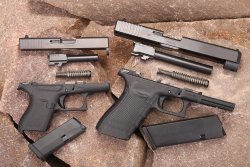
Besides the numerous static disciplines in the individual associations, the G41 could also be deployed in the IPSC standard class, as its total length of 225mm ensures it ideally fits into the prescribed box size. However, the 13+1 round magazine capacity means it trails the G35 in .40 S&W, also available as a Major, which accommodates 15+1 rounds. It would be well worth considering revising the trigger weight, and there are a number of tuners on hand to offer this service. Rationally speaking, though, the G41 is more of a makeweight in the product portfolio than the creation of a purebred sports weapon, which is thankfully a quality for which Glock pistols have never been designed.
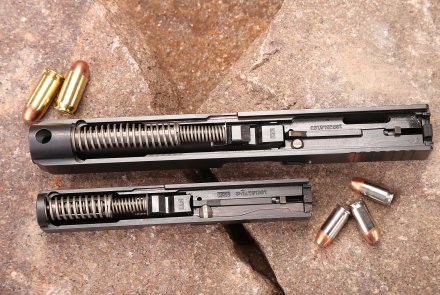
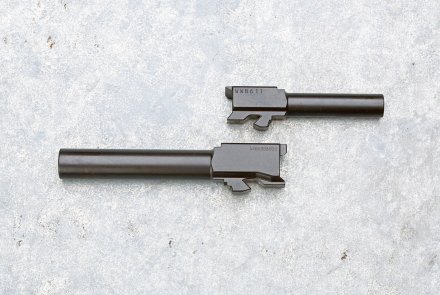
The smallest pistol from the Glock product portfolio, a manufacturer accustomed to success, was also shot from the sandbag rest over 15m, although this distance itself poses an almost sporting challenge to backup pistols that are otherwise fired exclusively in close quarters. Six factory cartridges in a weight range from 88 to 96 grains were used. Although still quite new, the Hornady Critical Defence with 90 grains delivered the best result of 38mm. The GECO and S&B FMJ cartridges secured second and third spots, respectively, producing 45mm. The average shot performance was 50mm, which is more than enough for the intended purpose.
Subcompact pistols in.380 – how small is too small?
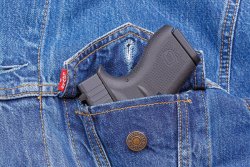
First and foremost, the international trend towards subcompact pistols in .380 caliber poses questions relating to what the cartridges can offer when it comes to terminal ballistics. A glance at the ballistics table for the GLOCK 42 reveals energy values in a range of 191 to 248 Joule for the ammunition we used. In comparison: the Luger 9mm, which holds a dominant position worldwide, delivers up to 500 Joule – almost twice as much – with an equivalent barrel length. A .38 Special from a typical pocket revolver, such as a Ruger LCR, produces 300 Joule – so almost equal in power – but weighs in with a higher projectile mass, which for reasons of fairness should be mentioned, also.
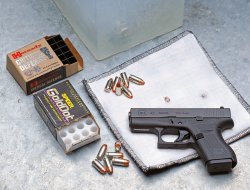
But even the Russian Military and the Armed Forces in the former satellite states have carried, and in some cases continue to carry, Makarov pistols in the eponymous caliber that operate on the same range as a .380 Auto when it comes to bullet weights and energies. So what is it about the short 9mm cartridge? To find out, we upgraded the assembly to include a terminal ballistics comparison in addition to the precision testing. We used a block of glycerin soap, which the manufacturer offers in a transparent form besides the almost opaque yellow, to enable recording of the expansion behavior with a high-speed camera.
In our case, it was quite easy to mold the transparent soap with food dye dissolved in water, hence lending the wound channel a richly contrasted, red coloration. We asked the projectiles to penetrate 'heavy clothing' (denim, several layers of cotton) as defined in FBI protocols to make the terminal ballistics comparison more practical and meaningful. A classic among the defensive cartridges went first, the Speer Gold-Dot. The bullet, 90 grains in weight, mushroomed very quickly and penetrated to a depth of 17cm.
Once recovered, the projectile displayed an average diameter of 14.5mm. The cavity that this long-running compound projectile left behind is equivalent to 41.9cm³ of water. Next up was the Hornady Critical Duty, which had already won the competition to equip one of the largest Sheriff Departments with backup ammo. Unlike the Speer Gold-Dot, it does not come with an exposed hollow point; instead, deformation is produced using a red plastic starter. Also 90 grains in weight, the FTX projectile penetrated the glycerin soap to a depth of 22cm. Once recovered, the projectile had a residual weight of almost 100%, as it only lost the red plastic tip.
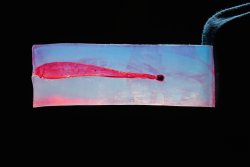
But the average projectile diameter with its very even mushrooming properties was 'merely' 11.5mm. We used the rest of the sliced soap for the light Magtech +P Guardian Gold with 85 grains of brass compound projectile and deep hollow point. It was not possible to measure the cavity as the projectile expanded very quickly and some of the temporary projectile cavity escaped outward from the sliced block of soap. Nevertheless, the projectile mushroomed to an impressive diameter of 15mm, but yielded 100% residual weight with a penetration depth of only 16cm.
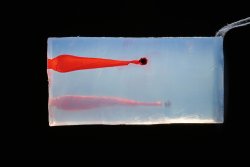
Interestingly, the S&B FMJ cartridge with its 248 Joule energy passed through the roughly 30cm block and the 'heavy clothing' as if it were jelly. Ultimately, the question of 'the' right defensive cartridge in .380 Auto caliber depends on what you're looking for. Some cartridges deliver greater penetration depth, while others produce more impressive mushrooming. We're all familiar with this fundamental debate from other calibers. One thing is certain, though: no one should underestimate the 9mm short when it comes to performance.
Summary: test of the new GLOCK 41 and 42 models:
The strict laws in Europe for civilians carrying firearms for personal defense are likely to make life somewhat difficult for the GLOCK G42 to become a top seller. The situation in the United States will be quite the opposite, though, as the run on small backup pistols appears set to continue unabated. The tradition that enshrouds this 'US' caliber on the other side of the big pond will almost certainly attract a large fan community for the G41, also. But it's likely to be tough going here in Europe, where sporting weapons in the more favorably priced 9mm are in trend. They're both a whole bunch of fun, though.



